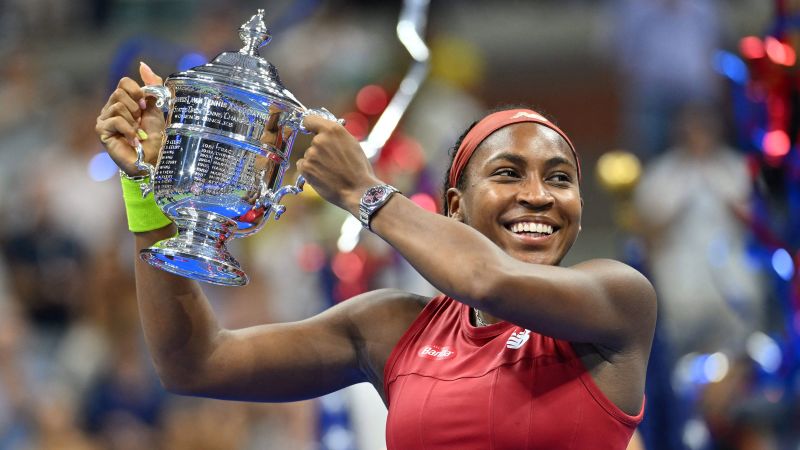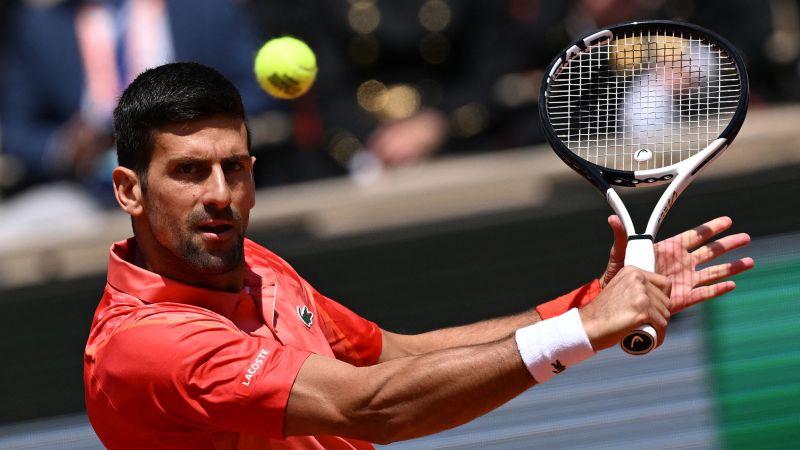How Novak Djokovic changed his game to become the GOAT
Goran Ivanisevic has seen it happen so many times over the past four years.
His star pupil, Novak Djokovic, shows up to the practice court in a foul mood, griping that his game is a disaster, that he needs to get better… at everything. His serve, his attacking play, even his backhand — one of the great backhands tennis has ever seen — it’s all a mess.
There is barely any acknowledgement of the resume, the 24 Grand Slam titles, the 74 other tour trophies, and more than 1,000 match victories. He’s got to improve, or he’s cooked.
“He’s crazy,” Ivanisevic said of Djokovic with a shake of the head, midway through last year, when Djokovic was in the midst of yet another of the greatest seasons any tennis player has ever put together and still whining to his coach at every turn.
Very good tennis players often express a desire to try to improve, and Djokovic is no different. But it’s one thing to say it, and it’s another thing to actually do it, especially after you’ve reached the pinnacle of the sport, over and over and over.
In 2015, Djokovic stampeded through perhaps the most ridiculous tennis campaign any man has managed. It’s the season Djokovic often mentions when he is asked to choose the best version of himself. That happens a lot now, since he has rendered the greatest male of all time debate moot — the only person left to compare Djokovic with is Djokovic.
He has won the most Grand Slam singles titles, the most Masters 1,000 titles, which are the next biggest events on the men’s tour, and has spent more weeks (406 and counting) ranked No 1 in the world than anyone else.
He reached all four Grand Slam finals in that 2015 season and won three of them (losing at the French Open to Stan Wawrinka). He went wire-to-wire as the world No 1. He played in 15 consecutive finals and won 11 of them. There was a ‘Big Four’ back then that also included Nadal, Roger Federer and Andy Murray. Djokovic went 15-4 against those three and was 4-0 against Nadal, his top rival.
Normal behavior after a season like that is to just keep doing what works. Djokovic doesn’t really do normal behavior, and he doesn’t really play tennis today the way he did in 2015, when he defended the court as few others could, then pulled rabbits out of hats, winning so many points he had no business winning.
That is a far cry from Djokovic’s winning formula last season, the one he will likely use to kickstart his 2024 this month in Australia. All of Djokovic’s best seasons share a theme — they get rolling in January in Australia, where Djokovic is about to try to win an 11th Australian Open men’s singles title. He won his 10th last year, the most in history.
He describes Australia as his “happy place”, a country where he finds his groove, and nothing — not even pulled or torn muscles — can take him out of it. He has not lost a match at the ‘A.O.’ in six years.
“It’s important to have the right start, kind of launch into the rest of the season,” he said during the United Cup, the mixed team competition he played before 2024’s first Grand Slam. “The more you win in a certain tournament, the more comfortable and confident you feel every next time you arrive.”
But Djokovic’s success is about so much more than good karma. It’s about figuring out how to change his game to accommodate his ageing body, which he acknowledges doesn’t move as well as it once did, and to keep up with the evolution of a sport that is now far less friendly to defenders who want to chase balls across the back of the court and pull rabbits out of hats.
With the top players hitting with more power and precision than ever, defending all day, rather than trying to take the initiative and finish points, has become increasingly difficult at the highest level.
Djokovic has had three truly epic years — 2011, 2015 and 2023. In each of them, he won three Grand Slam finals and armloads of other trophies.
Luckily for us, his last epic season before 2023 happened just after the revolution in advanced tennis analysis, making possible a revelatory deep dive into Djokovic then and now.
The metrics are the byproduct of ball and player tracking data collected through high-speed cameras and analyzed in real-time from technology developed by a British company, TennisViz, and Tennis Data Innovations (T.D.I), a joint venture of the ATP Tour and ATP Media.
These combined efforts have delivered fans, players and coaches information that previous generations could never dream of capturing, showing whether a player is attacking or defending on every shot; the quality of those shots based on the speed, spin, and landing spot; how often they win points they shouldn’t — their so-called steal score; how clinical they are at finishing points they should win; and how often they win the all-important baseline battles that so much of modern tennis has become.
The data tells the story of the evolution of Djokovic, from someone who specialized in winning tennis wars of attrition, to someone who now looks to attack at nearly every opportunity.
In numerical terms, the changes may seem, on the surface, to be incremental, but in a sport that turns on a handful of points in each match, seemingly small changes can result in big differences. Remember, Djokovic has won 14 of his 24 Grand Slam titles since 2015.
It starts with the serve.
Djokovic’s serve is nearly unrecognizable from 2015. Full props on that to Ivanisevic, who possessed a lethal serve in his playing days and has worked tirelessly with Djokovic since 2019, achieving startling results. Djokovic’s first serve averaged 120.1 miles per hour in 2023, compared with 115.4 in 2015.
That’s not about improved racket technology or lighter balls. The tour average has barely budged, rising from 116.1mph to 116.7.
That Djokovic serve is not only faster but also landing in better spots – five centimeters closer to the lines in 2023 than in 2015, and eight centimeters closer to them than the tour average. That’s important no matter what surface he is playing on, but it can be especially potent on the slick, fast ones of Melbourne Park, where serves to the sideline corners slide off the court almost instantly.
Djokovic has long been one of the great serve returners in tennis history. He’s better at that now, too. His return of his opponent’s second serve landed on the backhand wing on 47 per cent of points in 2023, compared with 39 per cent in 2015, putting him in a far better position to attack.
Once the points took shape last season, Djokovic seized an attacking position 26 per cent of the time, compared with 21 per cent in 2015. Tennis geeks refer to a player’s ability to win points from an attacking position as the ‘conversion rate’. Last season, Djokovic’s conversion rate was a clinical 72.1 per cent, top in the sport and 3.3 percentage points higher than his conversion rate of 68.8 per cent in 2015. The tour average is 66 per cent.
How did he become so clinical? His forehand got two miles per hour faster over the past eight years. That helps.
Also, his attacking position was 60 centimeters further into the court than it was in 2015, meaning he is hitting the ball far earlier than he used to, suffocating opponents by stealing split seconds from their recovery and preparation times.
The result of his increasing aggressiveness was a decrease in how much he had to defend, how many balls he had to chase down, and how many rabbits he had to pull out of hats. Tennis geeks refer to that as a player’s ‘steal score’, which is the percentage of points a player wins after being in a defensive position.
As thrilling as it is to claw back a point that appears lost, it’s exhausting and seriously hard on a 36-year-old physique. No one knows that better than Djokovic.
In 2015, Djokovic and Nadal co-led the sport with a steal score of 43.3 per cent. That is kind of crazy to think about — almost half the time their outgunned opponents had Djokovic and Nadal on the run, those poor overmatched souls still lost the point.
Last season, Djokovic’s steal score was a far less miraculous 36.4 per cent, still above the tour average of 34 per cent and a lot kinder to those 36-year-old knees. In other words, he’s still better than most at making magic happen when he needs to, but he’s become so much more efficient that he’s winning without expending as much energy.
It’s a logical strategy for any ageing great. Federer became more aggressive, and Nadal has tried to as well, coming to the net to finish points when the opportunities are there. But Djokovic has been more successful than both, winning so many of the biggest titles in the sport at this point in his career.
For opponents, there really is only one solution: attack before he attacks, make him run, and force him to play more defensively, the way he did during his previous tennis life.
Easier said than done, of course.
The winning formula has Djokovic setting big goals for 2024. “It’s not a secret that I want to break more records and make more history,” he said. “That’s something that keeps motivating me.”
He wants more Grand Slam titles, an Olympic medal, which has somehow eluded him, a Davis Cup with Serbia. He relishes thrashing the young guns — players two tennis generations removed from him who can’t understand how he has refused to give way.
Djokovic battled a wrist injury during the United Cup. But anyone banking on that stopping him should remember him winning the Australian Open last year with a seriously injured hamstring that Ivanisevic said would have caused most other players to quit and, in 2021, with a tear in an abdominal muscle.
“I know what I need to do to maintain my body and mind and spirit in the optimal state to have the opportunity to break records and to go further,” Djokovic said.
He still loves to play tennis, but winning continues to be the primary motivation, especially when he is on the road and away from his family for weeks at a time.
“That mentality is not changing for 2024 or any next year potentially that I play,” he said.
How he actually plays the game, well, that may be another, ever-evolving story.
Just ask Ivanisevic.
(Top photo: Manan Vatsyayana/AFP via Getty Images)







